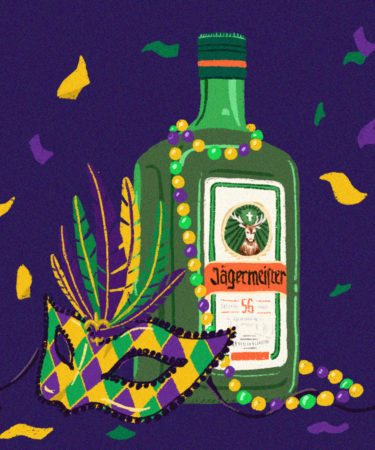Made with 56 herbs and spices — plus a whole lot of mystery — Jägermeister is a liqueur that most young Americans know and love. But how did this German digestif become a fraternity basement staple? The story starts on Bourbon Street.
In the late ’60s and early ’70s, Fritzel’s European Jazz Pub — a New Oleans bar that played 1920s-style jazz — almost single- handedly popularized Jäger among Bourbon Street bar goers. (The bar remains on Bourbon Street, and was still playing jazz before its temporary closing due to the coronavirus pandemic.) After founding the bar in 1969, Gunther “Dutch” Seutter promoted Jägermeister by selling it to Louisiana college students, according to drinks historian Wayne Curtis. Seutter, a German immigrant, was already familiar with Jägermeister, and began retrieving the spirit from German seamen who brought him the liqueur to New Orleans’ busy ports. Though at the time, Jägermeister was the most popular liqueur in Germany, it wasn’t distributed in the United States until 1973. As it would have taken a while to get into all 50 states, Curtis says, there’s a good chance that Fritzel’s was serving it before it was legally distributed — likely contributing to its illicit, mystical reputation.
The spirit’s popularity among Louisiana college students helped ignite the drink’s popularity countrywide — as the enigmatic drink was rumored to contain more than just alcohol. Since its ingredients are undisclosed, there have been many rumors regarding the contents of Jäger over the years. While some believe it to be vegan, others have surmised that it contains deer’s blood. Others, still, believed that Jäger caused temporary blindness, Curtis says. But what really sparked college-age interest in Jägermeister was a rumor among Tulane and LSU students in the ‘70s that the drink contained liquid Quaaludes or Valium, notes David Wondrich in his podcast “Life Behind Bars.”
Though it was already becoming popular among Lousianians in the know, the drink didn’t become a countrywide sensation until 1985, when a viral Baton Rouge newspaper article called it “liquid Valium” — further adding to the spirit’s aura of mystery and drawing an even larger crowd of college students, who all wanted to try out its supposed dulling effects. After this, sales exploded a hundred-fold. “That’s what college kids do. They look for stuff that will hurt you, and they exploit it,” Curtis says.
When American businessman and Jäger importer Sidney Frank caught wind of these rumors, he changed his marketing techniques, gearing his efforts to the same demographic that was making the spirit famous: College students. Inventing what has become the “shot girl” concept, Frank hired young, attractive, scantily clad women he dubbed “Jägerettes” to frequent college bars, handing out shots and spraying Jäger from water guns into patrons’ mouths. “He was a bit of a marketing genius,” says Curtis, adding that Frank was also a sexist. Frank was later sued for sexual harassment, and for failing to protect his Jägerettes from harassment.
Despite Frank’s unethical tactics, his decision to market Jäger as the college bar shot of choice proved successful, as the beverage maintains its hard-partying reputation even today — several decades later. When it comes to Jäger’s long standing notoriety, Curtis says, “Bourbon Street lit the fuse, but Sidney Frank provided the bomb.”
While Jägermeister now aims to outgrow its lowbrow reputation, it was no accident that the digestif ended up in more fraternity basements than fancy cocktail bars. And though the brand wants consumers to know that the liqueur can be used for much more than just “Jägerbombs,” let Jägermeister not forget that it has college students to thank for its early American success.
